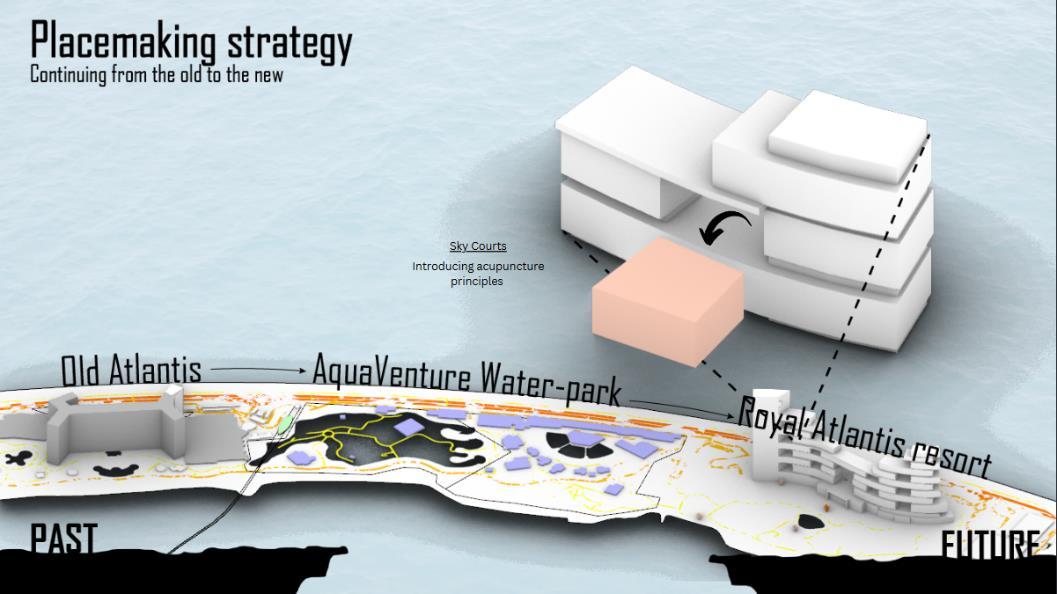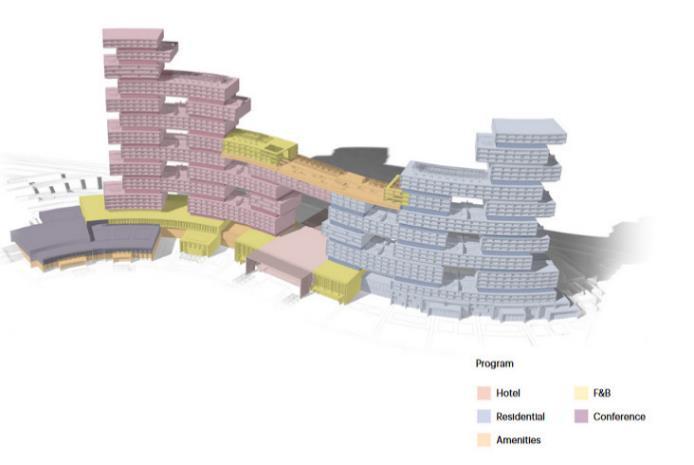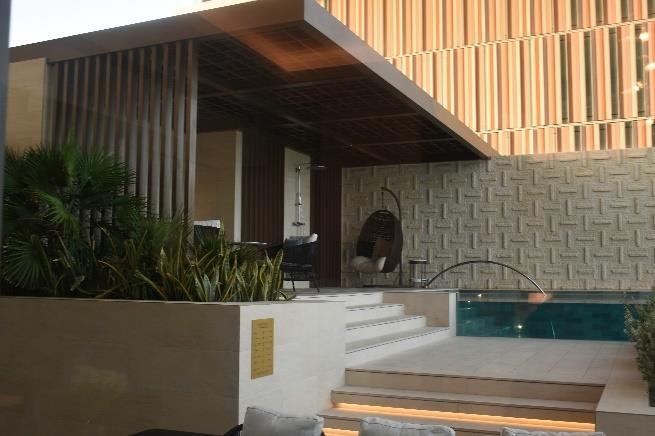The RoyalAtlantis Hotel
Sculpting Spaces
FromArch Gaps to Intricate Voids -APlacemaking Symphony at RoyalAtlantis

Avanish Dham – H00390040
Abstract
This essay explores the remarkable transformation of the Royal Atlantis Hotel in Dubai, originally vacant land, into a thriving urban development. It stands as a compelling example of a successful placemaking strategy that orchestrates a transition from the old Atlantis Resort's architectural style to a contemporary design. The study focuses on the strategic application of acupuncture principles, a design philosophy that involves the precise and deliberate insertion of architectural elements, and placemaking, the art of shaping public spaces to enhance their quality and vibrancy. This essay delves into how these strategies effectively rejuvenated a previously underutilized area, turning it into a thriving 'good place.' These strategies bridged the transition from the old Atlantis to the new, serving as catalysts for profound changes. The research aims to find its success through architectural elements, such as the iconic arch gap of the old Atlantis and the intricate voids of the Royal Atlantis, which play a pivotal role in shaping both the urban environment and the overall visitor experience. Therefore, by addressing these strategies, this paper aims to uncovers why the Royal Atlantis has emerged as a transformative force in the realms of urban development. The essay provides an in-depth analysis supported by case studies, examples, sketches, and data to examine how these strategies have reshaped the Palm and contributed to its extraordinary impact on the surrounding urban environment. The central focus of this study remains closely tied to the Royal Atlantis Hotel, its voids and gaps, and the consequential metamorphosis of the urban landscape.
Avanish Dham – H00390040 2
Outcome
This essay demonstrates the successful transformation of the Royal Atlantis Hotel in Dubai, exemplifying effective placemaking.
Emphasizing the shift from the old Atlantis Resort to contemporary design, the essay specifically highlights key architectural elements such as the shift from the iconic arch gap to the intricate voids as central to this revitalization.
The key outcome is to underscore the pivotal role of these architectural strategies in creating a thriving 'good place.' The essay aims to showcase the Royal Atlantis as a transformative force in urban development, emphasizing how innovative design, including the iconic arch gap and intricate voids, has reshaped both the visitor experience and the surrounding urban environment. Supported by case studies, examples, sketches, and data, the essay provides a comprehensive understanding of the impact of these features on the extraordinary metamorphosis of the urban landscape.
Hypothesis
The Royal Atlantis Hotel is a successful placemaking strategy, transitioning from the old Atlantis Resort to a modern design, employing urban regeneration and acupuncture principles. Architectural elements, including the old Atlantis' arch gap and the Royal Atlantis' voids, play a vital role in shaping the urban environment and visitor experience."
Avanish Dham – H00390040 3
Avanish Dham – H00390040 4 Table of Contents 1. Introduction 1.1. Embarking on the Art of Place Crafting …………………………………………………5 1.2. Why the Old Atlantis Resort? .............................................................................................6 1.3. Transition from the Old to the New………………………………………………………7 1.4. Urban Regeneration and Acupuncture in Architectural Transformation……………..9 1.5. Placemaking Strategies…………………………………………………………………...10 1.6. Societal Impact: A Fusion of Architecture and Community…………………………...13 2. Methodology: Evaluating the Royal Atlantis as a "Good Place”. 2.1. Assessment of Access and Linkage………………………………………………………17 2.2. Evaluation of Comfort and Image……………………………………………………….18 2.3. Analysis of Uses and Activities…………………………………………………………...19 2.4. Examination of Sociability………………………………………………………………..19 2.5. POE Results……………………………………………………………………………….20 3. Improvements 4. A Blueprint for Redefining Voids in Design – Global Benchmark 5. Implications 5.1. Implications on The Palm:………………………………………………………………..24 5.2. Implications in Dubai:…………………………………………………………………….25 5.3. Societal and Cultural Shift:………………………………………………………………25 6. Final Conclusion 6.1 Strengths and Innovations…...…………………………………………………27 6.2 Nuanced Improvements………………………………………………………...28 6.3 Global Blueprint for Design……………………………………………………28 6.4 Implications……………………………………………………………………...28
1. Introduction
1.1. Embarking on the Art of Place Crafting
Over the years, place-making has been implemented in many different places across the world and been increasingly used in a wide array of disciplines, including geography, planning, architecture, and sociology. (John Friedmann, 2010) In urban planning and design, placemaking is a multifaceted approach that centres around creating spaces with a distinct sense of identity, fostering community engagement, and enhancing the overall quality of life. (Innovation Quarter, 2022) It is a dynamic process that goes beyond conventional architectural considerations, emphasizing the importance of cultural, social, and environmental elements in shaping the character of a place. (Amrita Sen, 2019)
The Royal Atlantis Hotel in Dubai serves as a compelling case study for the application of strategic placemaking principles. (Innovation Quarter, 2022) The choice of placemaking as a focal point for the analysis stems from its capacity to go beyond traditional architectural paradigms. Instead, it seeks to understand how the design and utilization of public spaces contribute to the identity and vitality of a location. In the case of the Royal Atlantis Hotel in Dubai, placemaking becomes a compelling lens through which we explore the dynamic relationship between the old and the new. At the heart of this exploration lies the architectural marvel shared by both structures a central gap, echoing the iconic arch gap of the old Atlantis Resort. (Kerzner, 2023) Moreover, the Royal Atlantis introduces a modern twist with intricate voids seamlessly integrated into its design. These voids, strategically placed, serve as more than aesthetic elements; (Kerzner, 2023) they embody the essence of placemaking, creating spaces that go beyond the physical boundaries of the structure. This nuanced approach to placemaking not only rejuvenates the urban environment but also transforms a once underutilized area into a vibrant 'good place.'
Avanish Dham – H00390040 5
1.2. Why the Old Atlantis Resort?
The Palm Jumeirah in Dubai has long been celebrated for its opulent architecture, and at its heart, the old Atlantis Resort reigns as the primary focal point. Its iconic arch gap, seen from a distance while driving towards it, frames a void that draws the eye towards the endless horizon beyond, creating a captivating and almost surreal scene. The architectural marvel stands as a testament to Dubai's grandeur and vision. (Atlantis – the palm, 2023)
As you transition from the old Atlantis Resort to the new Atlantis, the Royal Atlantis Hotel introduces a new architectural approach from the captivating arch gaps to intricate voids, standing at 185 meters above sea level and comprising 43 stories, this architectural masterpiece serves as a beacon of sophistication and modernity. (Vadani, 2023)
In selecting the Old Atlantis Resort as the cornerstone of this exploration, its significance lies not only in its architectural prominence but also in its historical role as a hallmark of Dubai's luxurious identity (Atlantis –the palm, 2023). The arch gap, an unmistakable feature of the Old Atlantis, symbolizes not just a physical entrance but a gateway to the city's evolution. This deliberate choice serves to anchor the analysis in the rich heritage of Dubai's urban development, offering a compelling narrative thread that connects the past with the transformative present embodied by the Royal Atlantis Hotel. Like a red string symbolising fate and continuity from the old to the new
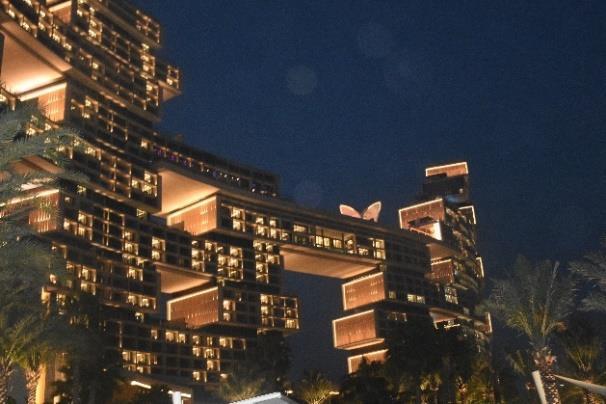
Avanish Dham – H00390040 6
Royal Atlantis at human Scale ©Avanish Dham
Visual Picture
1.3. Transition from the Old to the New
Visual Picture

Dubai's skyline has witnessed a remarkable transformation with the emergence of the Royal Atlantis Hotel, which now sits alongside the old Atlantis Resort on The Palm Jumeirah, sharing a vast 63 hectares of prime seafront real estate. The proximity of these two architectural marvels, merely 2 kilometres apart, makes for a leisurely walkable distance, allowing visitors to explore the rich contrast between tradition and innovation. (Hotelier, 2020)
Architectural Evolution: A Modernized Continuation
`The architectural narrative unfolds as the Royal Atlantis aims to be a modernized rendition of its predecessor, the old Atlantis, rooted in tradition, proudly showcases the classical horse-shoe Islamic arch, a symbol of cultural richness and historical resonance. This arch, while steeped in tradition, sets the stage for the Royal Atlantis to
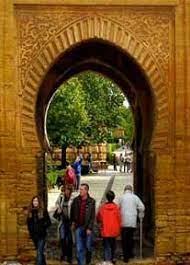
Avanish Dham – H00390040 7
Traditional Horse Shoe Arch from buffaloah.com
Visual Picture
Atlantis: Past and Future, Image from KPF

Avanish Dham – H00390040
take a departure from the cultural specificity of its forerunner.
However, both structures share the iconic central arch gap, a feature that serves as a symbolic entrance, welcoming guests into a world of luxury and sophistication. The Royal Atlantis intentionally adopts a more international and inviting architectural language. Additionally, the Royal Atlantis takes this legacy a step further by introducing additional voids, seamlessly integrating modern design elements into the architectural fabric.
While the old Atlantis Resort's arch gap remains a testament to the grandeur of its time, the Royal Atlantis elevates this concept by incorporating intricate voids strategically throughout its structure. These voids not only enhance the building's aesthetic appeal but also represent a deliberate departure from the conventional arch design. They serve as transparent windows into the interior, allowing natural light to cascade through the building and offering panoramic views that extend the visual experience beyond the structure itself.

8
Traditional Horse Shoe Arch in Atlantis, the palm ©Likith T, Edited by Avanish Dham
Intricate Voids in the Royal Atlantis, the palm ©Rob Garratt, Edited by Avanish Dham
Figure 1.2
Figure 1.1
In this architectural transition, the Royal Atlantis becomes a canvas of diversity, symbolizing Dubai's openness to global influences. The departure from the horse-shoe Islamic arch signifies a deliberate move towards a more inclusive and internationally welcoming design. The Royal Atlantis, with its contemporary elements, invites a diverse audience to experience its luxurious offerings, contributing to the cosmopolitan identity that Dubai continues to cultivate.

The juxtaposition of the arch gap's timeless elegance and the contemporary design of voids exemplifies Dubai's commitment to preserving architectural heritage while embracing innovation. The Royal Atlantis, with its fusion of classic and modern elements, stands as a living testament to the city's relentless pursuit of architectural excellence and its ability to seamlessly blend tradition with the avantgarde. In this dynamic transition from old to new, the Royal Atlantis not only pays homage to the past but propels Dubai into a future defined by cutting-edge design and urban sophistication.
1.4. Urban Regeneration and Acupuncture in Architectural Transformation
The transformation from the old Atlantis Resort to the Royal Atlantis goes beyond architectural evolution; it embodies urban regeneration principles and acupuncture in design philosophy. Urban regeneration on The Palm Jumeirah entails revitalizing underutilized areas, breathing new life into the urban landscape.
– H00390040 9
Avanish Dham
Sketch showcasing transition between traditionalism to internationalism, Sketched by Avanish Dham
Figure 1.3
Acupuncture in design involves deliberately and precisely inserting architectural elements to stimulate positive changes in the environment. For the Royal Atlantis, this includes preserving the iconic arch gap a symbolic bridge between tradition and modernity and strategically introducing intricate voids as architectural acupuncture points. These voids act as transformative elements, injecting vitality, and modernity into the urban fabric.
Figure 1.4
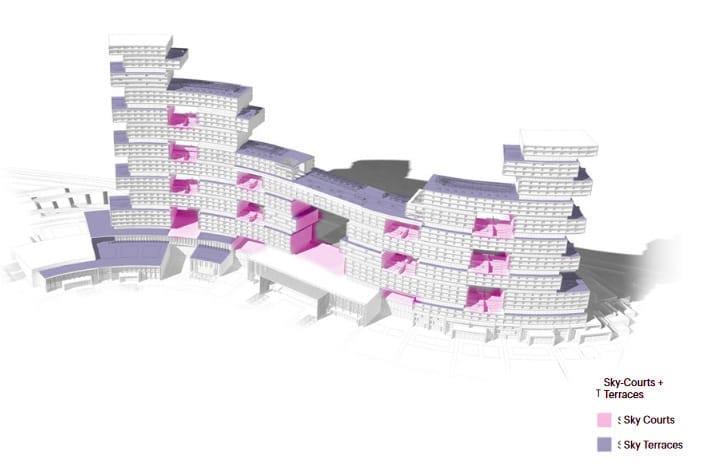 Edited by Avanish Dham
Edited by Avanish Dham
The result is not just a hotel; it's a dynamic force contributing to the comprehensive regeneration of The Palm Jumeirah. The intentional fusion of the arch gap with intricate voids creates a harmonious blend of tradition and innovation. This synergy ripples through the aesthetic and functional aspects of the surroundings, transforming once-vacant land into a vibrant and thriving urban development. The Royal Atlantis emerges as more than a structure; it acts as a catalyst for positive urban metamorphosis, seamlessly weaving tradition and modernity into The Palm Jumeirah's essence.
1.5. Placemaking Strategies
The Royal Atlantis Hotel transcends being a mere structure; it stands as a testament to the art of placemaking, strategically transforming a onceunderutilized area into a vibrant and dynamic 'good place.' This section explores the key placemaking strategies employed, with a focus on acupuncture principles and their impact on the urban environment.
Dham – H00390040 10
Avanish
Diagram from KPF showing sky courts and terraces created through the intricate voids
The Wider Spectrum of social spaces
Transcending its role as a luxury destination, the Royal Atlantis becomes a community hub where friendships are formed, neighbours meet, and strangers comfortably interact. The deliberate design of social areas, coupled with a commitment to hosting diverse events, fosters a sense of belonging. Residents and guests alike find common ground in shared spaces, contributing to the vibrant social fabric of the resort. Beyond the enchanting Sky Court and Sky Terrace discussed earlier, the deliberate design of social areas throughout the resort is profoundly influenced by the innovative use of intricate voids. These spaces include the dynamic Conference Centre, inviting Milos Restaurant, grand Hotel Lobby, and casual All-Day Dining. The innovative design extends to the elevated gardens-in-the-sky Sky Court and Sky Terrace exclusive to major suites. The Residential Lobby becomes a community focal point, and the opulent Sky Pool adds an extra layer of luxury, offering residents a space to relax and connect. Each space contributes to the resort's unique community-centric identity.
Visual Picture
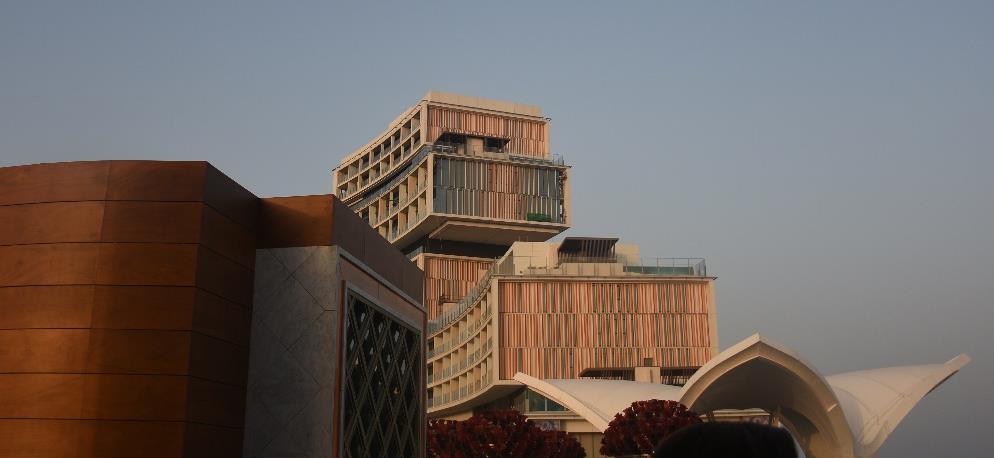
Avanish Dham – H00390040 16
View of the residential part of the structure from the sky terrace (common area where residence can meet guests) ©Avanish Dham
Avanish Dham – H00390040
Now, let's delve into the systematic approaches used to assess the Royal Atlantis's design and impact. The following sections explore its accessibility, comfort, uses, and sociability. By using a structured methodology, we aim to uncover the intricacies that contribute to the Royal Atlantis's success in transforming not just its physical surroundings but also the experiences within its urban sphere. Let's dive into the methodologies that reveal the layers of this architectural masterpiece.
2. Methodology: Evaluating the Royal Atlantis as a "Good Place”.
The Royal Atlantis Hotel proudly secures its position as the 44th best hotel in the world, a prestigious accolade awarded at the inaugural 50 Best Hotels ceremony in London. This esteemed list celebrates hotels from 35 diverse locations across six continents, marking a significant milestone for 50 Best's expansion into the global travel space after a decade since the launch of The World's 50 Best Bars in 2009. (Royal Atlantis, 2023)
2.1. Assessment of Access and Linkage
Observation: On approaching the Royal Atlantis, the intricate voids play a role on an architectural scale more than a human scale. While the grandeur of these voids contributes to the overall visual impact of the resort, at the human scale, their presence might not be as pronounced during the initial approach.
Data Collection: Understanding the perception of these voids from the perspective of arriving guests, the data collection involved feedback on whether the intricate voids influenced their sense of arrival and ease of orientation.
Evaluation:
17
• Ease of Accessibility: 9/10
• Transportation Options: 8/10
Avanish Dham – H00390040
Findings: While the intricate voids may not be immediately apparent at the human scale during arrival, they contribute significantly to the overall visual appeal of the Royal Atlantis and are intricately tied to the experience of accessing the resort.
2.2. Evaluation of Comfort and Image
Observation: The intricate voids, when experienced within the resort, contribute profoundly to the interior comfort. They create visual connections between different spaces, allowing for a play of light and shadow that enhances the overall ambiance. Importantly, these voids facilitate a seamless connection between indoor and outdoor environments in specific areas.
Data Collection: Guest feedback emphasized the role of intricate voids in shaping perceptions of comfort and luxury. Visual assessments considered the impact of these voids on the overall image of the resort, particularly how the interplay between indoor and outdoor spaces influenced comfort.
Evaluation:
• Interior Comfort: 9/10
• Overall Aesthetic Appeal: 9/10
• Indoor-Outdoor Connection: 8/10
Findings: The intricate voids, acting as conduits between indoor and outdoor spaces, contribute significantly to the comfort and aesthetic appeal of the Royal Atlantis. This connection allows guests to experience the surrounding environment, enhancing the overall sense of luxury and providing a unique and comfortable atmosphere.
18
2.3. Analysis of Uses and Activities
Observation: In various functional areas of the Royal Atlantis, intricate voids play a role in defining the spatial experience. In accommodations, these voids provide unique views and lighting conditions, while in dining areas, they contribute to a dynamic and visually engaging atmosphere.
Data Collection: Surveys and guest interviews delved into how intricate voids influenced the perception of accommodations and dining experiences, capturing the essence of their role in creating diverse and appealing spaces based on variations on different activities.
Evaluation:
• Range of Accommodations: 9/10
• Dining Experiences: 9/10
• Recreational Facilities: 8/10
Findings: The integration of intricate voids in various functional areas enhances the distinctiveness of accommodations, dining spaces, and recreational facilities, contributing to the overall richness of uses and activities at the resort.
2.4. Examination of Sociability
Observation: Social spaces within the Royal Atlantis, influenced by intricate voids, provide a visually stimulating backdrop for social interactions. These voids create semi-private zones within communal areas, fostering both intimacy and connectivity.
Data Collection: Analysis of social media interactions and direct interviews explored how intricate voids contributed to the diversity of social spaces and influenced community interactions.
Avanish Dham – H00390040 19
Evaluation:
• Diversity of Social Spaces: 9/10
• Community Interaction: 8/10
Findings: The intricate voids, by creating visually captivating social spaces, contribute to the diversity of interactions within the Royal Atlantis, enhancing sociability and fostering a dynamic community atmosphere.
This structured evaluation provides a nuanced understanding of the Royal Atlantis' strengths, setting the stage for the subsequent sections of improvement and overall conclusion.
2.5. POE Results
This survey, conducted by Avanish Dham, serves as a valuable research initiative aimed at confirming findings and conducting an overall evaluation of the intricate voids in the Royal Atlantis. The survey took place on November 17th, with a targeted sample size of 6 users who were thoughtfully selected to provide diverse perspectives. Avanish Dham, as the researcher, carefully crafted the survey to delve into the nuanced aspects of user experiences and perceptions regarding the intricate voids within the Royal Atlantis. The insights gathered from this survey contribute to a more comprehensive understanding of how these architectural elements influence the overall assessment of the Royal Atlantis.
The results of the POE can be found if you click here Can also be found in issuu.com/avanishdham
3. Improvements
While the evaluation highlights the overall success of the RoyalAtlantis in utilizing intricate voids, some nuanced improvements can further enhance the resort's functionality and guest experience:
Dham – H00390040 20
Avanish
Human-Scale Visibility:
Observation: Voids may not be immediately noticeable at a human scale during the approach and entry to the site, primarily observed architecturally or from afar. This makes the interior ambiance somewhat generic.
Recommendation: While this characteristic may add to the overall visual appeal, consider subtle design interventions to enhance the visibility of voids at a human scale, providing a more engaging and immersive experience for guests upon arrival.
Positive Aspect of Limited Visibility:
Observation: The subtlety of voids being architecturally noticeable rather than immediately evident at a human scale during entry could be considered a positive aspect.
Recommendation: Embrace and enhance this aspect by incorporating elements that make the gradual revelation of voids an intentional part of the guest experience, contributing to a sense of anticipation and discovery.
Overall Conclusion:
The Royal Atlantis stands as a remarkable achievement in architectural innovation. While the improvements suggest refinements in specific areas, the resort's success in utilizing voids to create a 'good place' is evident. By addressing these nuanced aspects, the Royal Atlantis can further solidify its status as a global architectural landmark, providing guests with an unparalleled and dynamic experience that seamlessly integrates luxury, comfort, and environmental responsiveness.
Avanish Dham – H00390040 22
4. A Blueprint for Redefining Voids in Design – Global Benchmark
The Royal Atlantis Hotel, with its groundbreaking use of intricate voids and the transformation of these spaces into functional sky lounges and sky courts, sets a compelling precedent for architects and designers globally. This innovative approach offers a blueprint for creating social spaces through the strategic implementation of voids, challenging conventional design norms. Architects and designers can draw inspiration from the Royal Atlantis to envision voids not just as structural elements but as dynamic spaces with a specific function. (Woodcraft, 2023) The concept of sky lounges and sky courts provides a tangible example of how voids can be harnessed to foster social interaction and redefine the purpose of void spaces in architectural design.
Embracing Internationalism in Architecture:
Moreover, the Royal Atlantis stands as an icon for a shift towards internationalism in design. By seamlessly blending traditional elements like the horse- shoe arch gap with contemporary void spaces, the resort embodies a universal architectural language. This shift from a singular cultural identity to a more inclusive and international design philosophy allows architects to break free from cultural constraints, encouraging a diverse and global perspective in their creations. The Royal Atlantis becomes a symbol of a borderless design ethos, inspiring architects worldwide to embrace a more cosmopolitan approach in their projects.
Transformative Architecture: The Dynamic Use of Void Spaces:
The structural composition of the Royal Atlantis, with human-scaled blocks arranged strategically to optimize views and stacked over dramatic voids, creates the awe-inspiring 'sky-courts' and stepped towers housing 'sky-terraces' and penthouses. (KPF, 2023) This
Avanish Dham – H00390040 23
intentional design blurs the lines between indoor and outdoor spaces, providing a myriad of options for different uses. Some areas are designed for private enjoyment, offering exclusive experiences for residents, while others remain public, fostering community engagement. This flexibility in design allows architects to explore diverse use cases for voids, (KPF, 2023) creating environments tailored to specific needs. (Proctor, 2023)
Human-Scaled Design in Mega Structures:
The mega structure's towering presence not only provides breathtaking views but also maintains a human-scale touch. Despite its height, the Royal Atlantis manages to create a sense of intimacy by offering various levels of 'sky-terraces' and penthouses that bridge the gap between the monumental structure and human interaction. (KPF, 2023) This unique design choice enhances the overall experience, allowing users to feel the height, enjoy panoramic views, and engage with different layers of the building. This human-scale approach to a mega structure opens possibilities for architects globally to redefine how tall structures can be designed to remain accessible, functional, and socially engaging.
In essence, the Royal Atlantis Hotel serves as a trailblazer for future architectural endeavours globally. Architects and designers can leverage its innovative use of voids, the concept of sky lounges and sky courts, and the synthesis of cultural and contemporary elements to create spaces that transcend borders and cater to diverse societal needs. The resort's success in achieving a harmonious blend of internationalism, functionality, and human-scale design provides valuable insights for the evolution of architectural practices on a global scale.
5. Implications
5.1. Implications on The Palm:
Avanish Dham – H00390040 24
The transformative impact of the Royal Atlantis on The Palm heralds a new era in urban development. The introduction of intricately designed voids, now transformed into sky lounges and sky courts, positions The Palm as a nucleus for avant-garde and socially conscious design. These voids redefine the skyline, contributing to The Palm's luxurious and forward-thinking identity. As the Royal Atlantis sets a new standard, future developments on The Palm are likely to draw inspiration from this paradigm shift. Anticipate innovative void spaces becoming integral to creating vibrant communal areas, enhancing the overall living experience. The royal Atlantis is regarded as architectural masterpiece and a new icon for Dubai (Proctor, 2023)
5.2. Implications in Dubai:
Dubai, renowned for its architectural marvels, experiences a profound ripple effect from the Royal Atlantis's intricate voids. The city's skyline, characterized by bold and futuristic structures, now reflects a design philosophy prioritizing community, connectivity, luxury and dynamic social spaces. (Bayut, 2023) This influence is expected to extend to future projects across Dubai, with architects and developers embracing the notion of voids as more than visual elements. The Royal Atlantis's impact on Dubai's social fabric is significant, shaping a narrative of inclusivity and engagement that resonates throughout the city's architectural evolution. (Proctor, 2023)
5.3. Societal and Cultural Shift:
Across the globe, the introduction of voids in architectural structures, promoting social spaces and seamless indoor-outdoor interactions, marks a significant cultural shift. This approach challenges traditional design norms, fostering community bonds and a sense of togetherness. (Woodcraft, 2023)
Architectural Equality
Dham – H00390040 25
Avanish
The use of voids breaks down barriers, creating shared spaces that everyone can access. This move reflects a cultural value of inclusivity, where architecture becomes a means of bringing people together, regardless of their background. (Woodcraft, 2023)
Community Interactions
Voids turn structures into lively platforms for social exchange, reshaping the relationship between individuals and their built environment. This shift emphasizes community engagement, transforming static buildings into dynamic spaces for shared experiences. (Woodcraft, 2023)
Nature’s Influence
Architects are increasingly recognizing the importance of nature in urban life. Voids that facilitate transitions between indoor and outdoor spaces align with a cultural awareness of the positive impact of green areas on mental well-being. (Woodcraft, 2023)
Architectural Storytelling
Architects, inspired by successful designs like the Royal Atlantis, are now storytellers. Voids in architecture represent more than open spaces; they tell stories of inclusivity, sustainability, and a desire for connected living. (Woodcraft, 2023)
New definition of Luxury
The integration of voids challenges traditional ideas of luxury. Instead of focusing on expensive materials, luxury is redefined as an immersive experience. This shift reflects a cultural landscape where luxury is associated with thoughtful, experiential design that enhances life quality.
Avanish Dham – H00390040 26
In essence, the cultural shift towards incorporating voids in architecture signifies a move towards inclusivity, community engagement, nature integration, architectural storytelling, (Woodcraft, 2023) and a redefined concept of luxury. As architects and societies globally embrace this shift, the built environment becomes a canvas for cultural expression, enriching lives and fostering a deeper sense of connection to the spaces we inhabit.
6. Final Conclusion
The Royal Atlantis Hotel emerges as a symbol of architectural innovation and urban transformation, seamlessly blending tradition with modernity on The Palm Jumeirah in Dubai. The intentional integration of intricate voids, now transformed into sky lounges and sky courts, positions the Royal Atlantis as a trailblazer in global architecture. Through a nuanced evaluation, the resort's success is evident, particularly in creating a 'good place' that transcends traditional boundaries.
6.1 Strengths and Innovations
• Cultural Continuity: The resort successfully connects the old and the new, weaving a narrative that respects Dubai's architectural heritage while embracing international influences. The iconic arch gap, inherited from the old Atlantis, acts as a visual bridge between tradition and innovation.
• Placemaking Mastery: The Royal Atlantis exemplifies the art of placemaking, transforming an underutilized area into a vibrant community hub. The voids, strategically placed, go beyond aesthetic appeal, influencing how people engage with the environment and fostering a dynamic relationship between the interior and exterior spaces.
• Social Integration: The intricate voids contribute to a diverse range of social spaces, creating a vibrant tapestry of interactions.
Avanish Dham – H00390040 27
From exclusive sky courts for residents to communal areas that encourage connections, the Royal Atlantis transcends its role as a luxury destination to become a community-centric identity.
6.2 Nuanced Improvements
While the resort excels in its overall design, some nuanced improvements can enhance its functionality and guest experience. Recommendations include refining the visibility and impact of voids at a human scale, considering weather-responsive designs, and ensuring voids play a more pronounced role in specific spaces like accommodations and dining areas.
6.3 Global Blueprint for Design
The Royal Atlantis sets a global benchmark for architects and designers, showcasing how voids can be dynamic spaces with specific functions. Its synthesis of cultural and contemporary elements offers a blueprint for creating inclusive and socially conscious designs. The resort's success in embracing internationalism, human-scale design, and transformative architecture provides valuable insights for future architectural endeavors worldwide.
6.4 Implications
The impact of the Royal Atlantis extends beyond its physical presence, influencing The Palm, Dubai, and global architectural practices. The resort shapes a new era in urban development, with voids becoming integral to avant-garde design. Dubai's skyline reflects a shift towards community-centric, luxurious, and socially engaging spaces. Globally, the cultural shift towards architectural inclusivity, community engagement, and redefined luxury signifies a profound transformation in how societies interact with their built environment.
Avanish Dham – H00390040 28
In essence, the Royal Atlantis stands not just as a luxurious hotel but as a cultural phenomenon, reshaping the narrative of architecture, community, and societal connections on a global scale. As architects and communities worldwide embrace the lessons from this architectural masterpiece, the Royal Atlantis paves the way for a future where the built environment becomes a dynamic canvas for shared experiences, inclusivity, and cultural expression.
Avanish Dham – H00390040 29
References
Friedmann, J. (2010). Place and place-making in cities: a global perspective. Planning Theory & Practice, 11(2), 149–165. https://doi.org/10.1080/14649351003759573 [Taylor & Francis Online], [Google Scholar]
Innovation Quarter (2022) Placemaking, Innovation Quarter. Available at: https://www.innovationquarter.com/articles/placemaking/ (Accessed: 19 November 2023).
Amrita Sen & Harini Nagendra (2019). The role of environmental placemaking in shaping contemporary environmentalism and understanding land change, Journal of Land Use Science, 14:4-6, 410424, https://doi.org/10.1080/1747423X.2020.1720841
Royal Atlantis (2023) Atlantis the royal named no. 44 in the inaugural ranking of the world’s 50 best hotels 2023, making it a Dubai first. Available at: https://www.kerznercommunications.com/atlantis/royalatlantis/atlantis-the-royal-named-no-44-in-the-inaugural-rankingof-the-worlds-50-best-hotels-2023-making-it-a-dubai-first/ (Accessed: 14 November 2023).
Kerzner Communications (2023) Design and architecture. Available at: https://www.kerznercommunications.com/atlantis/royalatlantis/design-and-architecture/ (Accessed: 14 November 2023).
Atlantis 2023 About Atlantis, the Palm: Luxury Hotel & 5 star resort in Dubai, About Atlantis, The Palm | Luxury Hotel & 5 Star Resort In Dubai. Available at: https://www.atlantis.com/atlantis-the-palm (Accessed: 14 November 2023).
Avanish Dham – H00390040 30
Vadani, B. (2023) The royal atlantis resort & residences, BESIX. Available at: https://www.besix.com/en/projects/the-royalatlantis-resort-residences (Accessed: 15 November 2023).
Hotelier, M.E. (2020) What you need to know about Atlantis, the Royal Resort, Five things you didn’t know about Atlantis, The Palm Dubai . Available at:
https://www.hoteliermiddleeast.com/business/124666-what-youneed-to-know-about-atlantis-the-royal-resort (Accessed: 15 November 2023).
DubaiTourism (2023) Dubai receives 14.36 million international visitors in 2022, Happiness Meter. Available at: https://www.dubaitourism.gov.ae/en/newsroom/pressreleases/2022visitorperformance (Accessed: 15 November 2023).
KPF, A. (2023) Homepage - KPF, The Royal Atlantis . Available at:
https://www.kpf.com/wp-content/uploads/importedfiles/2208_Royal_Atlantis_final.pdf (Accessed: 15 November 2023).
Proctor, R.A. (2023) Atlantis the royal: An architectural masterpiece and new icon for Dubai, Arab News. Available at: https://www.arabnews.com/node/2238051/lifestyle (Accessed: 19 November 2023).
Bayut, M. (2023) The history of Dubai’s Modern ArchitectureMyBayut, A blog about homes, trends, tips & life in the UAE | MyBayut. Available at: https://www.bayut.com/mybayut/historyof-dubai-architecture/ (Accessed: 21 November 2023).
Woodcraft, S. (2023) UCL discovery - Thesis, 1 VOID POTENTIAL. Available at:
https://discovery.ucl.ac.uk/id/eprint/10071841/7/Woodcraft_1007 1841_thesis.pdf (Accessed: 21 November 2023).
Avanish Dham – H00390040 31







 Edited by Avanish Dham
Edited by Avanish Dham

